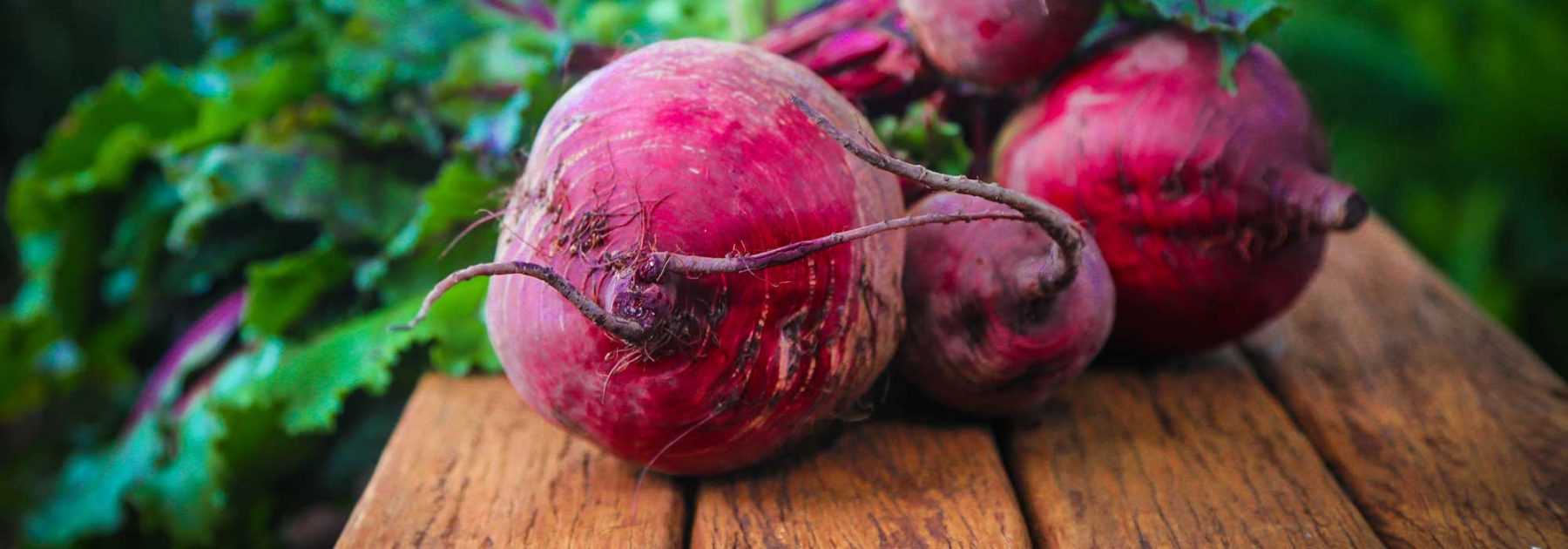
Beetroot: Sowing, Planting, Growing and Harvesting
Contents
The beetroot in a nutshell
- Beetroot is a hardy vegetable that thrives in cool, rich soil and full sun exposure.
- There are three main types: garden beetroot, sugar beet and fodder beet.
- It’s an easy-to-grow vegetable, though sowing requires thinning out.
- Beetroot can be harvested from May until the end of the year in mild climates, and its young leaves are also edible.
- Its health benefits are well-known, particularly its very high antioxidant properties.
Our expert's word
The Beetroot – Beta vulgaris – is a hardy biennial root vegetable, harvested in its first year of growth. Its fleshy root can be eaten cooked or raw, rich in slow-release carbohydrates and renowned for its high vitamin, antioxidant and mineral content, making it an excellent slimming food. The young green leaves make a wonderful addition to mixed salads.
There are three main categories of beetroot: table, sugar and fodder varieties. In this article, we’ll focus mainly on table beetroot, which varies in shape depending on the variety: cylindrical like the famous ‘Crapaudine’, spherical, or flattened like the ‘Egyptian Flat’. They also differ in colour (not all beetroots are red – they can also be white, golden yellow like the ‘Burpee’s Golden’, orange or even pink), and of course in flavour and carbohydrate content. While most beetroots are harvested at maturity, some can be enjoyed young, like the ‘Bonel’ variety, ideally eaten as a “baby vegetable”.
In the vegetable garden, beetroot likes to have its head in the sun but its feet in cool soil, thriving in moist conditions. The soil should also be fertile, particularly rich in potash, which aids root development. Sowing, whether early or in season, can be done in seed trays or directly in situ in open ground. Thinning will be necessary as each seed (glomerule) sown produces several beetroot plants. Thinned seedlings can be transplanted. The rest of the cultivation requires standard tasks like weeding, hoeing, watering and protecting the soil with an organic mulch.

Description and botany
Botanical data
- Latin name Beta vulgaris
- Family Chenopodiaceae
- Common name Betterave
- Flowering Bisannuelle cultivée en annuelle
- Height 6 ans
- Exposure Soleil
- Soil type Frais et riche
- Hardiness rustique à très rustique
The first selections of garden beetroot by humans date back to Antiquity, with written records in Greece going back 5 centuries before Christ. However, its geographical origin is believed to be Mesopotamia. It wasn’t until the Middle Ages that descriptions of the varieties of the time reappeared. Fodder beet developed in Germany in the 16th century, followed by the first selections of sugar beet in Poland during the 18th century.
Botanically very close to chard (or Swiss chard), beetroot was previously written as “bette-rave” to distinguish the fleshy root of this plant from the leaf stalk of chard. The genus name, Beta, comes from the Latin bēta (chard, pear) and the species name comes from the Latin vulgaris (common, ordinary).
We distinguish three subspecies:
- Garden beetroot, commonly called “Red Beet” – Beta vulgaris var. esculenta – cultivated for human consumption.
- Fodder beet – Beta vulgaris var. rapa – used to feed animals, especially in winter.
- Sugar beet – Beta vulgaris var. altissima – used to extract sugar and produce bioethanol!
Beetroot belongs to the Chenopodiaceae family according to the classical classification or to the Amaranthaceae family according to the phylogenetic classification. Beetroot is a biennial herbaceous plant (cultivated as an annual). In the first year of cultivation, the beetroot develops its vegetative system: at the beginning of growth, it’s mainly the leaves that grow first, arranged in a rosette and emerging from the crown. They are light green in colour, often veined with red, and can reach up to 30 cm in length. The root develops at ground level, not underground. Its growth occurs progressively from the start, but it’s mainly during the final months of cultivation that the beetroot stores reserves, causing the root to swell rapidly. In the second year, if not harvested, the beetroot produces a flowering stem that can reach 1.5 m in height, with green, hermaphroditic flowers grouped in whorls. After fertilisation, the seeds form glomerules. Each glomerule contains up to four seeds, fused together and difficult to separate.
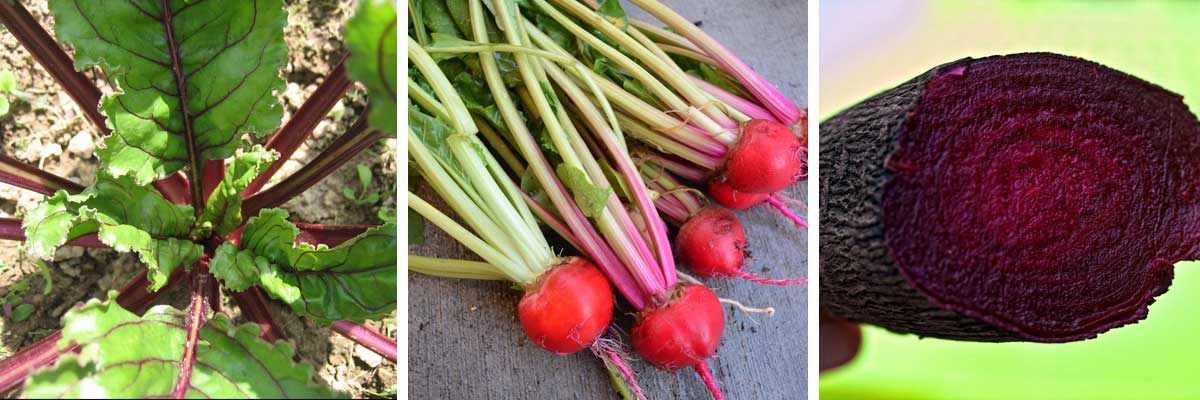
Green leaves with red veins arranged in a rosette – Leaves emerge from the crown – Cross-section of Crapaudine beetroot
Beetroot Varieties: Red Beetroots and Other Colours
Beetroot varieties are distinguished by their colours, shapes, and flavours. Here they are classified by colour.
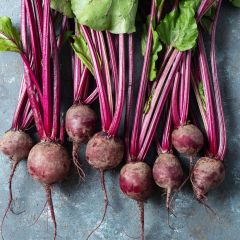
Bonel Red Beetroot - Beta vulgaris
- Flowering time May to July
- Height at maturity 30 cm
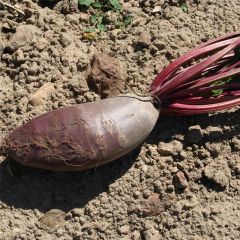
Beetroot Covent Garden - Ferme de Sainte Marthe Seeds
- Flowering time May to July
- Height at maturity 40 cm
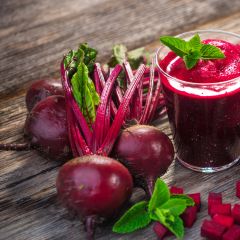
Organic Detroit Improved 2 Bolivar Beetroot - Ferme de Sainte Marthe seeds - Beta vulgaris
- Flowering time May to July
- Height at maturity 40 cm

Moneta Red Beetroot - Beta vulgaris
- Flowering time May to July
- Height at maturity 40 cm

Flat of Egypt Beetroot
- Height at maturity 30 cm

Albina Vereduna White Beetroot - La Ferme de Sainte-Marthe
- Height at maturity 25 cm

Beetroot Burpees Golden Organic
- Height at maturity 25 cm

Chioggia Beetroot - Ferme de Sainte Marthe seeds
- Flowering time May to July
- Height at maturity 40 cm

Beet - Beta vulgaris
- Height at maturity 40 cm
Discover other Beetroot seeds
View all →Available in 1 sizes
Available in 1 sizes
Available in 1 sizes
Available in 1 sizes
Available in 1 sizes
Available in 1 sizes
Available in 1 sizes
Available in 1 sizes
Available in 1 sizes
Sowing beetroot and transplanting
Where and when to sow your beetroot?
Beetroot is generally sown directly in the ground, but for early crops it’s perfectly possible to sow in seed trays:
- For early crops, sow from late February to April in seed trays. Transplanting usually occurs when the first direct sowings take place, around April. This method allows for harvesting from May to July.
- For seasonal crops, sow from mid-April to July directly in open ground for a harvest from July to October.
How to sow beetroot seeds?
Technically we should refer to them as seed clusters rather than seeds. Except for “monogerm” varieties like ‘Magenta’ beetroot, each cluster produces several seedlings.
For tray sowing:
- Fill the tray two-thirds full with compost and lightly firm with a trowel.
- Place the clusters, leaving at least 3 cm between each one.
- Cover with a thin layer of sowing compost using a sieve and lightly firm with a trowel.
- Water using a spray bottle.
- When seedlings reach 10 cm and/or five leaves, transplant them into open ground, spacing them 20 cm apart and selecting the most vigorous plants.
For direct sowing:
Beetroot prefers cool, loose soil. Begin by loosening the soil with a broadfork and level with a rake. If needed, add some wood ash as beetroot appreciates potassium. (Related reading: “Wood ash: how to use it in the garden”). If necessary, add well-rotted manure or mature compost to the drills.
Sow directly in rows:
- Create drills 1-2 cm deep, spaced 25-30 cm apart,
- Sow a cluster every 5 cm,
- Cover with fine soil then firm with the back of a rake,
- Water gently and maintain soil moisture until germination!
Once seedlings reach 10 cm and/or five leaves, thin them out by selecting the most vigorous plants and spacing them 20 cm apart.
Thinning beetroot
From the 5-leaf stage (about 10 cm tall), beetroot must be thinned as each cluster will have produced multiple seedlings. Water the soil before thinning to make it easier, keeping only one plant every 20 cm.
Removed seedlings can be transplanted elsewhere, but weaker ones should be composted.
Planting beetroot and transplanting
Beetroot seedlings sown in trays or purchased as young plants are transplanted into the garden, in prepared soil as for sowing, when they have at least 5 leaves.
Transplanting bare-root beetroot
- “Dress” the young plants by trimming one third of the foliage and root
- Make a hole using a dibber
- Place your plant then fill in with soil,
- Water immediately and provide shade if necessary as beetroot doesn’t tolerate transplanting well. Ideally, carry out the transplanting in the evening or on an overcast day. In the following days, ensure the beetroot establishes well by watering regularly – they will particularly appreciate regular misting of the foliage.
Planting beetroot in mini-plugs
Beetroot can also be grown from young plants, in mini-plugs. These mini-plugs, at least 2 cm wide at their base, have the advantage of reducing transplant shock compared to bare-root transplanting, so the success rate is often higher.
Here’s how to plant them:
- A quarter of an hour before planting, place your mini-plugs in a saucer filled with water, preferably not too cold, to rehydrate them. This step is essential for successful establishment! For an extra boost, add some comfrey tea to the saucer – 1/5th of the water volume is a good ratio.
- On your prepared bed, mark out rows spaced 25 to 30 cm apart.
- Plant one mini-plug every 20 cm. Each plug should be buried up to its top edge – there’s no need to plant it deeper.
- Water immediately, gently with a watering can or using a gentle spray from a hose.
- In the following days, monitor the plants’ establishment: the plugs must remain moist while the roots develop in the soil. If the weather is hot and sunny, temporary shading with upturned crates or shade cloth won’t go amiss!
Pairing beetroot in the vegetable garden
Beetroot thrives when planted near lettuce, carrots, parsnips, celery (both stalk and celeriac), headed cabbages and rocket.
However, it’s best to avoid planting it alongside spinach, Swiss chard and orach as they belong to the same family, as well as asparagus, leeks and tomatoes.
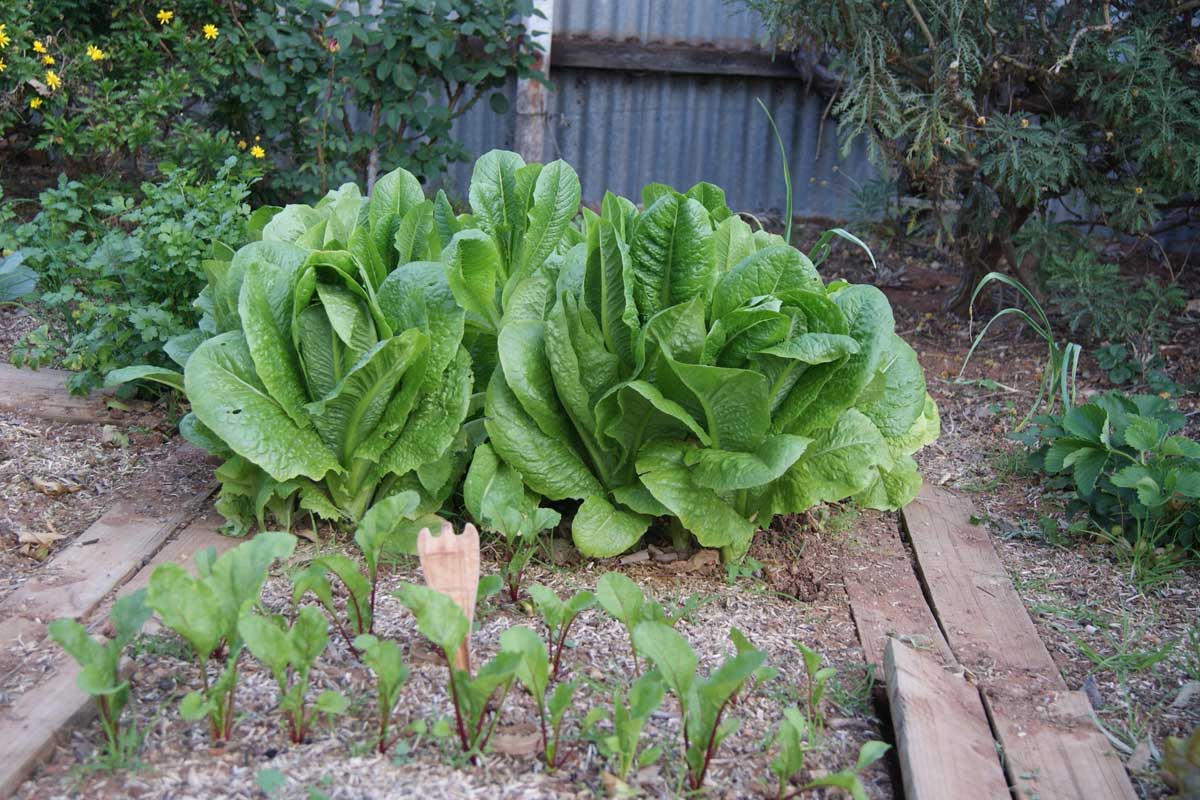
Beetroot and lettuce make good garden companions
Cultivation and care
Ongoing Care During Cultivation
During cultivation, beetroot does not require specific maintenance, apart from regular hoeing and weeding. Water during hot and dry weather to prevent the root from becoming woody and hard. As beetroot prefers cool soil, remember to mulch as soon as possible. Also keep an eye out for leaf spots (see diseases below).
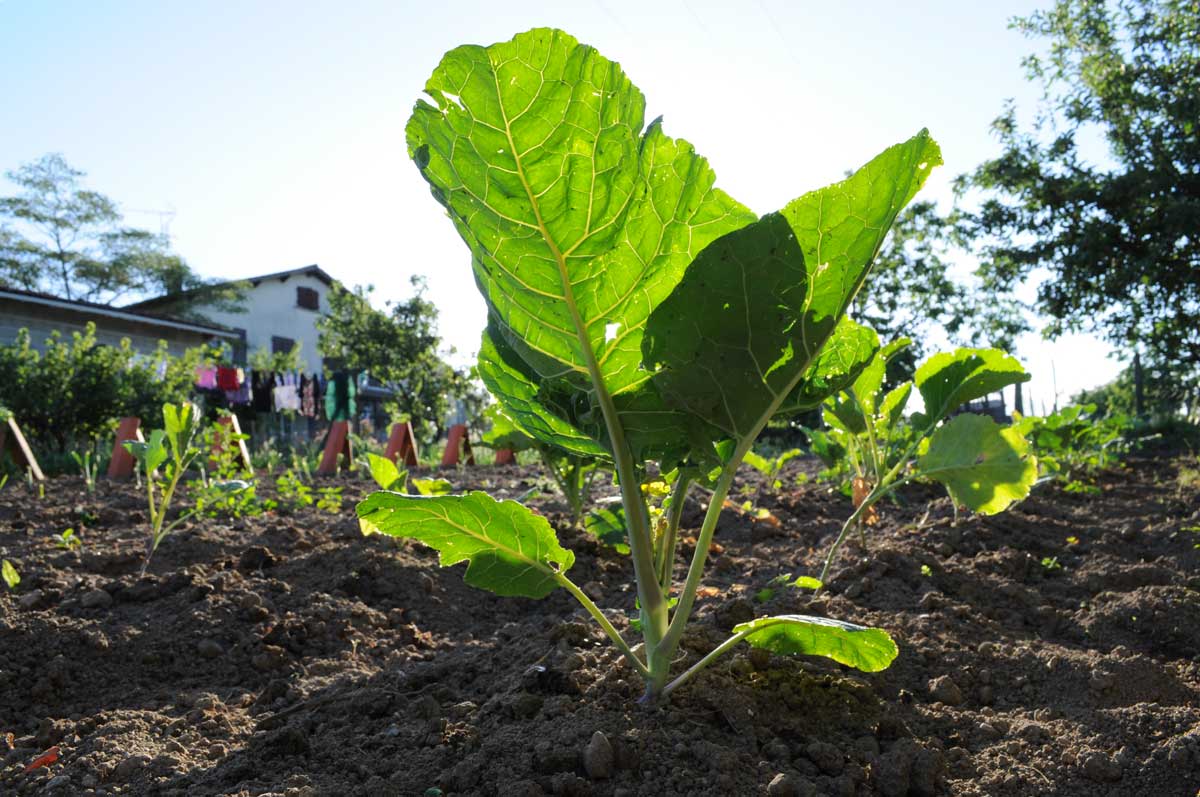
A beetroot plant
Beetroot Pests and Diseases
At the scale of a family vegetable garden, it is quite rare for beetroots to be affected by diseases or attacked by pests. However, the two main issues you might encounter are Cercospora leaf spot and the beet fly.
Cercospora Leaf Spot of Beetroot
Cercospora leaf spot is a fungal disease caused by Cercospora beticola. This fairly common disease appears as small round spots on the upper surface of leaves, which are brown to grey in colour with a red border. Severely affected leaves dry out and die.
Damage can be significant if the disease strikes early, as root development is reduced. However, if it occurs late in the growing season, the impact is minor. We still recommend cutting off and disposing of infected leaves to reduce the risk of spreading the disease. As a preventive measure, water your beetroots directly at the base using a watering can, avoiding overhead watering on the leaves.
This disease can be confused with Ramularia leaf spot (Ramularia beticola), which has similar symptoms and causes comparable or less severe damage. With Ramularia, the border of the necrotic spots is dark brown rather than red.
The Beet Fly
The beet fly, also known as the beet leaf miner (Pegomya betae), is a pest whose larvae tunnel through beet foliage. The first generation of larvae, which coincides with the start of the growing season, can cause the most significant damage and affect the survival of young beet plants. However, this pest is less common in home gardens than in large-scale cultivation. Simply keep an eye out and remove any leaves showing signs of tunnelling.
→ Learn more about beetroot diseases and pests in our advice sheet.
Harvesting and Storing Beetroot
Early cultivation allows for beetroot harvesting from May through to July, while seasonal cultivation yields crops from July to October, or even later in regions with mild climates.
Some gardeners harvest young leaves to use in mixed salads. If you do this, be careful not to exhaust the plants so they can still develop their roots.
To store beetroot throughout winter, it’s best to keep them in a cool, dark place such as a cellar or pantry. For optimal preservation and to maintain their flavour, you can bury them under a layer of dry sand. In mild climates, they can be left in the ground, simply protected with mulch.
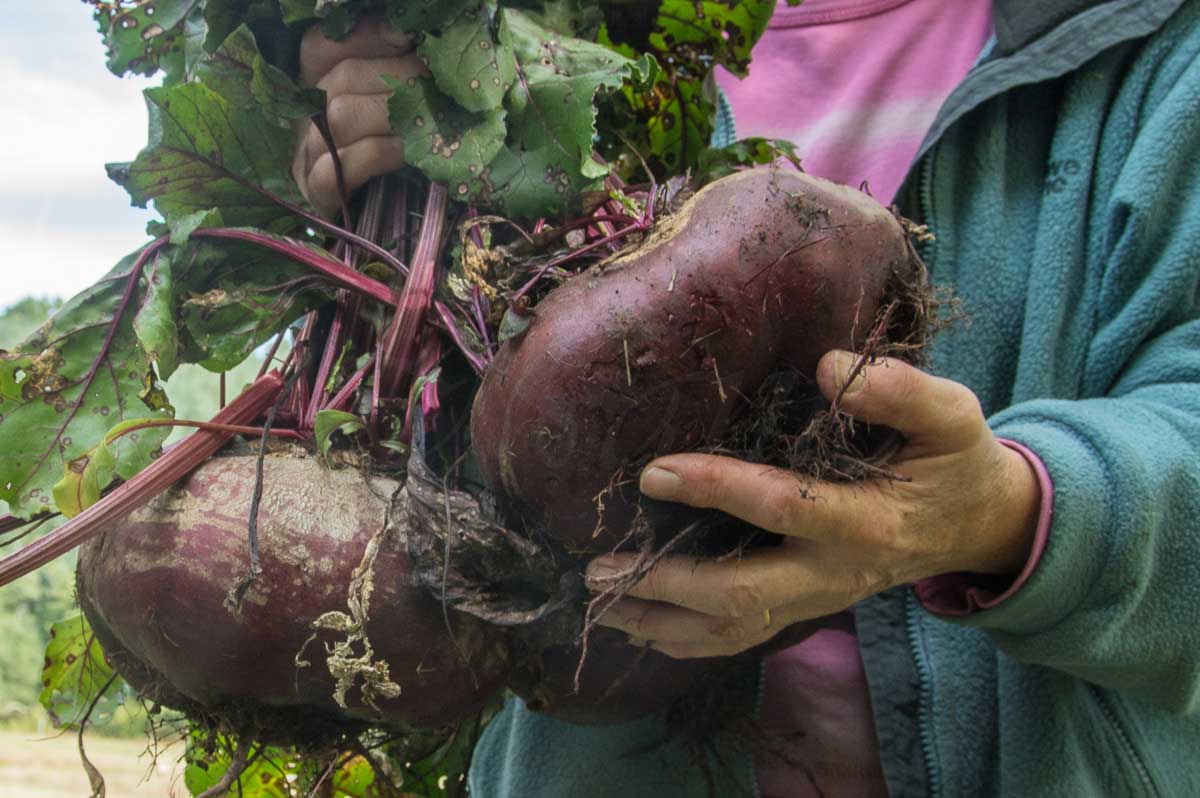
A fine beetroot harvest!
Uses and Nutritional Benefits of Beetroot
Beetroot is most commonly eaten cooked, but it is also edible raw. Note that it is when cooked that it provides the most antioxidants. There is no shortage of recipe ideas, and it is often even featured in gourmet dishes. It can simply be cooked and cut into pieces, blended with fresh goat’s cheese, used in soups like Russian borscht, or grated to add colour to salads… The young leaves are also excellent in mixed salads.
Beetroot is a vegetable that consists mainly of slow-release carbohydrates, followed by fibre and protein. Rich in various vitamins, particularly B9, which aids in proper cell renewal and the healthy development of the foetus in pregnant women. The antioxidant power of beetroot is very high; antioxidants such as lutein, zeaxanthin, betalains, and flavonoids are compounds that protect the body from ageing, cardiovascular diseases, and help prevent the risk of cancer. It has been scientifically proven that betalain (betaine), a pigment, reduces the risk of skin, liver, and lung cancer in animals. This same molecule is what turns urine red. Beet leaves are also rich in flavonoids (antioxidants), making young shoots a welcome addition to salads!
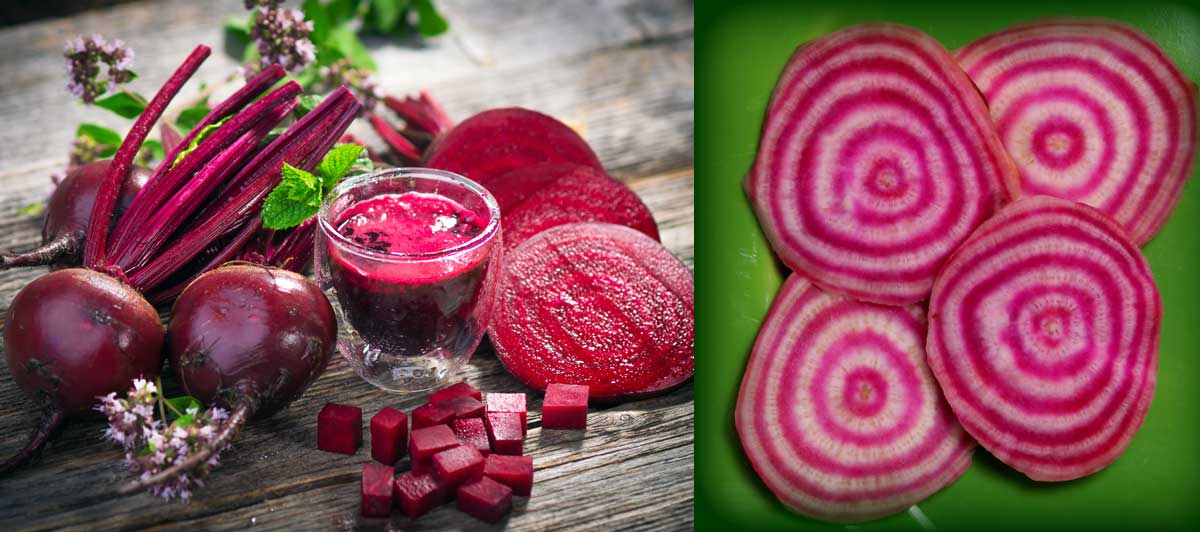
The many uses of beetroot
Saving Your Own Beetroot Seeds
The first year of cultivation is the same as for consumption, but there’s no need to sow too early, summer sowings are best for seed production. In autumn, in very cold winter climates, the roots are dug up and stored in clamps before being replanted in March. In milder climates, they can be left in the ground and covered with leaves to overwinter. Select beetroots according to the characteristics of the species. Discard any roots that are diseased or infested with insects.
As pollination occurs via wind, it’s highly recommended to only produce seeds from one variety per year, as cross-pollination would be inevitable with two varieties. Also avoid letting Swiss chard go to seed in the same year, as they can cross-pollinate with beetroot. Flowering stems appear in spring of the second year – it’s advisable to stake the plants to prevent them from falling over. By August, the seed clusters mature and the stems are harvested once thoroughly dry. Then separate the seed clusters from the stems and pass them through a coarse sieve to make the task easier.
Useful resources
Discover our range of beetroots: available as seeds and plug plants.
Our advice sheets: Beetroot, the best varieties and Choosing a beetroot
Pascale explains how to make vegetable crisps
Advice sheet: Fodder plants, 5 vegetables for animals
Frequently asked questions
-
My beetroots aren't growing, why?
Beetroots that sprout but don't grow larger can have several possible causes, sometimes multiple combined factors: - Have they been thinned out? Like carrots, if beetroots are planted too close together, they won't grow properly. - Are they well-watered? Beetroots love water and moist soil. Consider mulching in summer to retain soil moisture. - Another possible cause is soil fertility. If surrounding vegetables are also stunted, your soil may lack organic matter. Add compost and water your plants with nettle manure diluted to one-fifth strength.
- Subscribe!
- Contents


































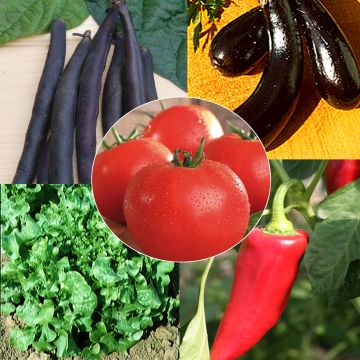
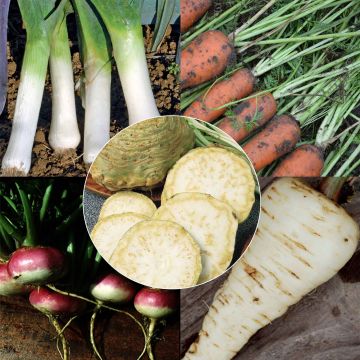
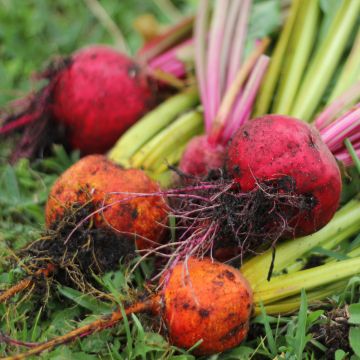

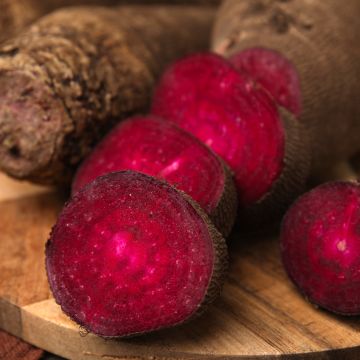

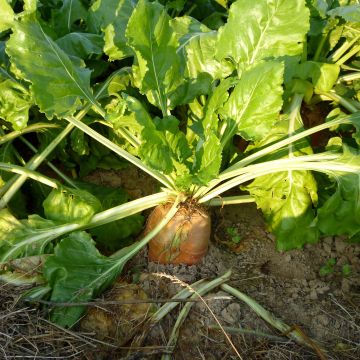
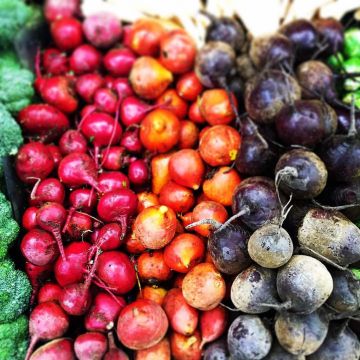
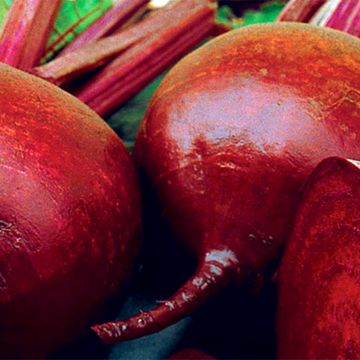
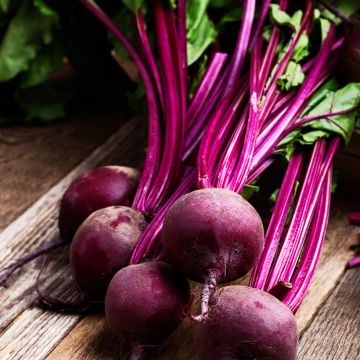
Comments